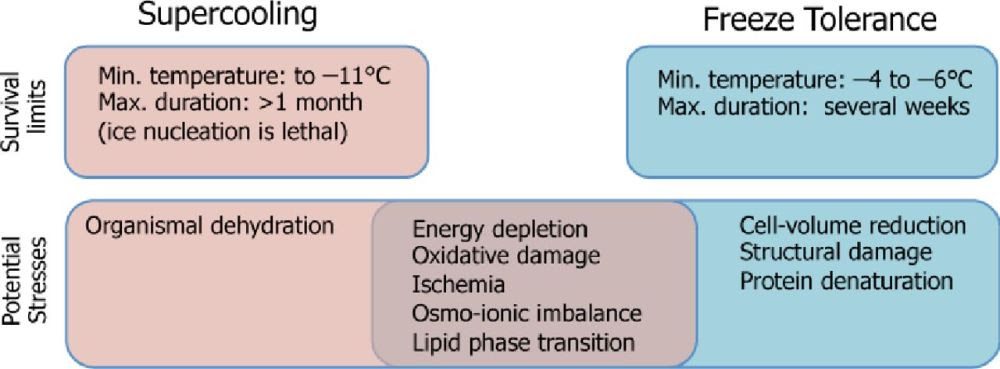This week, we’re wrapping up our series on insect winter ecology with what could be the most extreme winter survival strategy of all: Freeze tolerance. Freeze tolerance is a strategy by which insects (and occasionally other animals) allow ice formation within their tissues, as opposed to supercooling or avoiding frost formation altogether.

Before we get into the mechanism of freeze tolerance, it’s important to understand why freezing is so detrimental in the first place. As ice crystals form within the body, they grow and occupy the space outside our cells, the extracellular space. In order to continue growing, ice crystals need a consistent source of water, so it is leeched from the surrounding cells via osmosis, causing the cells to shrink and become dehydrated and deformed.
As the ice crystals continue to grow, the situation becomes even more dire, as extracellular space becomes limited and cells can literally be crushed or punctured by the growing ice crystals. This is the same process that leads to frostbite in our own bodies. Poor cells.

So how do freeze tolerant insects combat ice formation within their bodies? As you might have guessed, freeze tolerance is a total 180 from freeze avoidance. Instead of removing ice nucleators from their body, freeze tolerant insects actually produce ice nucleating proteins in order to initiate and regulate ice formation within their extracellular space (and occasionally, in their intracellular space).
Since ice crystals can form spontaneously at low temperatures, insects that practice this strategy try to get ahead of the curve by producing these proteins at relatively warm temperatures. This allows them to regulate the formation of ice crystals in the case of a sudden temperature drop. Remember, freeze tolerance is a strategy predominantly practiced by insects in the southern hemisphere, where temperatures can drop suddenly and for short periods of time. This is opposed to the northern hemisphere, where we experience longer, extended periods of seasonal cooling and insects have a chance to prepare for winter accordingly.

Once ice crystal formation is initiated within the insect’s body, the insect must now face the challenge of preventing cells from becoming dehydrated and/or damaged. They do this by producing cryoprotectants, a strategy similar to freeze avoidant insects. The most common cryoprotectant, again, is glycerol. Glycerol is less polar relative to water, and is therefore able to “distract” the hydrogen bonds between two water molecules.
In other words, the formation of glycerol in cell tissue prevents the cell from becoming dehydrated in the first place by preventing intracellular water from being leeched out through osmosis.
Phew! Biochemistry.

So, why evolve these two strategies at all? When comparing the two strategies, freeze avoidance certainly seems like a safer alternative to freeze tolerance, so why practice the latter at all?
It all comes down to temperature and seasonality. If you recall from our issue on freeze avoidance, insects start producing ice nucleating inhibitors slowly over time, beginning as the temperature drops as we move into fall, so that by the time winter arrives, the insects are prepared for the freeze.
Freeze tolerant insects act on a much shorter timescale, producing ice nucleating proteins at a temperature relatively warmer than the temperatures at which freeze avoidant insects produce ice nucleating inhibitors. Again, this is a strategy practiced by a majority of insects in the southern hemisphere, where temperature drops can be sudden, extreme, and short-lived.
But, as with most things, there are exceptions to the rule, so stay tuned! Winter is just getting started.